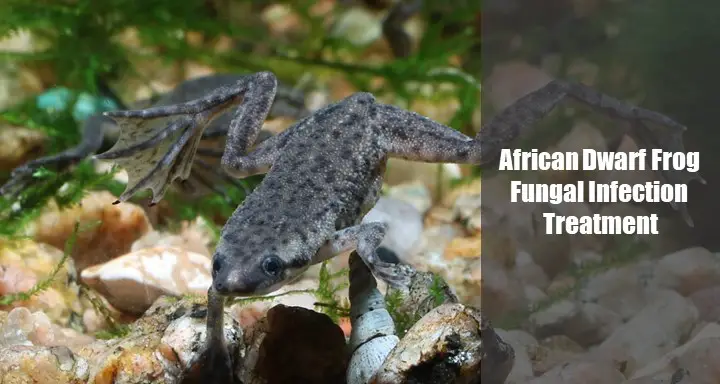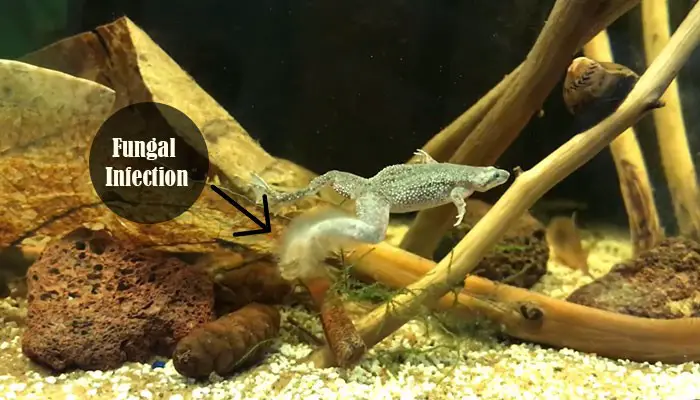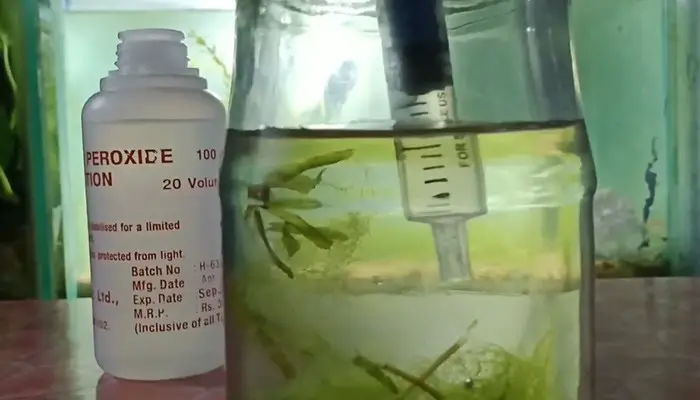
The African dwarf frogs are mainly popular as aquatic pets. Besides, people also like to call them dwarf-clawed frogs.
In addition, they are small and have many color varieties- brown with black spots, olive green, and much more. However, although the African dwarf frog is ideal as an aquatic pet, it easily gets sick by bacteria, fungi, or even parasites.
Typically, fungi such as Chytridiomycosis, Zygomycosis, Saprolegniasis, and Chromomycosis are responsible for the dwarf frog’s fungal infections. Moreover, some of them are fatal. So, you should make proper arrangements for the African dwarf frog fungal infection treatment.
But before starting the treatment, you should figure out what type of fungus attacks your dwarf frog. This article will tell the nature of those gruesome fungi and how to diagnose them along with their treatment.
So, let’s get down to it.
African Dwarf Frog Fungal Infection Treatment

Chytridiomycosis Infection
If you wonder what kills African dwarf frogs, then the obvious answer is the chytridiomycosis fungus. It is the most fatal infection among all fungi. Sadly, it is strong enough to kill your dwarf frog.
To begin with, this chytrid fungus typically belongs to the Batrachochytrium genus. It can spread fast from one body to another. As a result, no species are safe from this fungus.
In other words, if your African dwarf frog gets affected by Chytridiomycosis, then all your aquatic pets will get affected and die as well.
In this case, you need to figure out the signs of this fungal infection as soon as possible. Moreover, the infection starts to show its symptoms on frog skin. So, read the points below to diagnose the Chytridiomycosis infection-
- Frogskin gets rough and reddish.
- Skin loses its authentic color.
- Skin peeling and sometimes it becomes excessive.
- The dwarf frog eventually loses its appetite.
- It floats on the aquarium water and hides behind decorations all the time.
- It shows less activity day by day.
- Excessive mucus production.
- Muscles may become senseless.
These are the symptoms of chytrid fungus. In addition, another important symptom of any kind of fungal infection is a white knee or white patches on the knees. So, you also should notice if your African dwarf frog has a fuzzy foot.
Treatment
You should not waste any single time starting the treatment after finding out about the chytrid fungus. The chytrid infection has several stages and each stage requires different treatment. But it is easy to treat the dwarf frog in the first stage.
Now we will see different methods of treatment.
Temperature Treatment
The temperature treatment helps quite a lot to reduce the chytrid fungus. Usually, the chytrid fungus Bd (Batrachochytrium dendrobatidis ) is temperature-sensitive. A study shows that this fungus cannot survive at a temperature above 32 degrees Centigrade.
In this case, set the aquarium temperature from 37 to 47 degrees Centigrade. In this way, the temperature will kill the chytrid fungus within four hours.
Bath Solution
Another study shows that topical itraconazole (0.01%) or quality fish antifungal is very effective in eliminating the chytrid Bd fungus. To do this, bath your African dwarf frog with a 0.01% itraconazole solution for 5 minutes every day. (Our Pick: API POND PIMAFIX Antifungal Pond Fish Infection Remedy)
Hopefully, the fungus will be removed within 10-11 days of this process. However, a recent study case has found that this process contains some side effects. So, take advice from a vet before applying this method.
Other Medications
It is always the best idea to communicate with a vet as soon as possible. However, if you find out the sign at the early stage, you can use diluted hydrogen peroxide or benzalkonium chloride. (Our Pick: Amazon Basics Hydrogen Peroxide)
Another recommended medication can be 1-2% Malachite green. You have to use it once a day to clean the fungus. (Our Pick: Malachite Green, 1% Aqueous Solution)
Saprolegniasis Infection
Saprolegniasis infection is a skin disease of amphibians and a kind of water mold is responsible for this infection. That’s why the aquatic African dwarf frog can easily get this fungal infection.
This African dwarf frog skin disease has two kinds of forms. But both forms are dangerous- can be life-threatening. Moreover, they can attack from the eggs to the adults- any life stage of the frog.
So, diagnose your dwarf fog as soon as possible. To help you with this, we have made a list of symptoms for you.
- The first noticeable thing is the cotton patches on the frog’s skin. They can be white, brown, gray, or green.
- The frog’s skin loses its color day by day.
- The red rash can be seen around the pale areas.
- The African dwarf frog loses its appetite and weight as well.
- The frogs may vomit from time to time.
Treatment
You should start the treatment right after diagnosing your dwarf frog. For this purpose, you must consult with a vet. The overall treatment process can be like this-
- Water diagnosing is the most important thing before starting the treatment. Test the temperature, ammonia nitrogen level, and pH level of the water with a test kit. (Our pick: VIVOSUN pH and TDS Meter Combo)
- If the temperature is low, then raise the temperature of the water up to 68 degrees Fahrenheit.
- Use a topical solution like itraconazole or any kind of salt solution.
- First, gently remove the white fungus on the African dwarf frog and then apply the medicine.
- If the disease becomes severe, then the veterinarian may suggest a good antibiotic.
Zygomycosis Infection
Zygomycosis is rare but a serious fungal infection and the mucormycosis mold is responsible for this. In addition, they are commonly found in clay, animal matter, or decomposing veggies.
That’s why the African dwarf frog often gets affected by this severe fungus. What’s more, this fungus spreads fast and causes death within two weeks.
The common symptoms of zygomycosis are-
- Discoloration of skin.
- Rash in the abdomen area.
- Multifocal hyperemic nodules on the skin.
- Visible fungus in the mouth area.
- Lethargy.
Treatment
Immediate treatment is crucial for this African dwarf frog skin disease. But the bad news is- there is no effective treatment solution for this infection.
However, call a vet as soon as possible after diagnosing this disease. But beware: isolate the affected frog from other aquatic animals immediately. Finally, some advanced antifungal properties may ease the infection.
Chromomycosis Infection
Chromomycosis is a fungal infection caused by the black or pigmented fungi of the organic aquarium substrate or decomposed plants. That’s why aquatic frogs often get attacked by this infection.
The dangerous part is- this fungus not only affects the epidermis but also attacks the subcutaneous tissue layers. Besides, it can be also fatal If you do not take the necessary arrangements in time.
The symptoms of the chromomycosis infection are-
- Open sores.
- Weight loss.
- Loss of appetite.
- Inflammation.
- Head tilt.
- Loss of balance.
- Anorexia.
- Skin lesions.
Treatment
Let me be honest with you. This severe fungal infection is not treatable in most cases since the frogs affected by this disease die fast.
However, if you figure out the disease early, some antifungal medications can be the slightest chance for the survival of your African dwarf frog.
General Prevention

We already know how African frogs get fungal infections. However, we can take some advanced actions to prevent any kind of fungal infection.
Besides, some extra management is also important after the African dwarf frog fungal infection treatment. So, read the points below to know more-
- Try to avoid organic substrate in the fish tank.
- Remove any dead plants from the aquarium immediately.
- The aquatic water quality must be at the first-class level. Firstly, the density should be appropriate. Secondly, the temperature of the water must not be more than 68 degrees Fahrenheit. Finally, the ammonia and the pH balance should be appropriate.
- Quarantine the affected fish from the main tank instantly. Thus you can prevent the spreading of the fungal infection.
- After the frog dies of fungal infection, overall sanitation is necessary for the tank to eliminate all the fungus.
African dwarf frog water parameters
| Water Parameter | Ideal Range |
|---|---|
| Temperature | 75°F to 82°F (24°C to 28°C) |
| pH Level | 6.5 to 7.5 |
| Water Hardness | 2 to 12 dGH or 30 to 214 ppm |
| Ammonia (NH3) | 0 ppm (zero) |
| Nitrite (NO2) | 0 ppm (zero) |
| Nitrate (NO3) | Below 40 ppm |
Frequently Asked Questions
Is the Chytridiomycosis fungal infection fatal?
The chytridiomycosis fungus can be fatal. If you find out the symptoms of the chytridiomycosis fungus at the early stage, then you can save your African dwarf frog with proper treatment. However, your frog may face death if it is not treated in time.
Why do the African dwarf frogs have cotton patches?
The African dwarf frogs are shedding because of the fungus. In most cases, dwarf frogs get white or gray cotton patches on their skin. This sign shows that your frog gets a fungal infection.
Why are the African dwarf frogs shedding?
It is a natural phenomenon if your dwarf frog peels its skin from time to time. However, if your frog sheds skin abnormally, then it is a sign of a fungal infection. In this case, take the necessary steps as soon as possible.
Conclusion
The fungal infection is extremely dangerous for any kind of amphibian species. Especially, when any pet frog like the African dwarf frog gets affected by the infection, it becomes more dangerous.
Since most fungal infections are contagious, they spread fast and affect other animals. Besides, they are fatal. So, your African dwarf frog is not safe from this infection.
As a result, the African dwarf frog fungal infection treatment is necessary as soon as possible right after diagnosing the actual fungus.
We hope that you will find all the important information in this article.
Read More
- Top 15 Freshwater Aquarium Plant Ideas for a Lush, Green Tank - November 9, 2024
- Top 13 Freshwater Aquarium Layout Ideas for a Beautifully Organized Tank - November 9, 2024
- 14 Stunning Rustic Freshwater Aquarium Ideas for a Tranquil Environment - November 9, 2024
